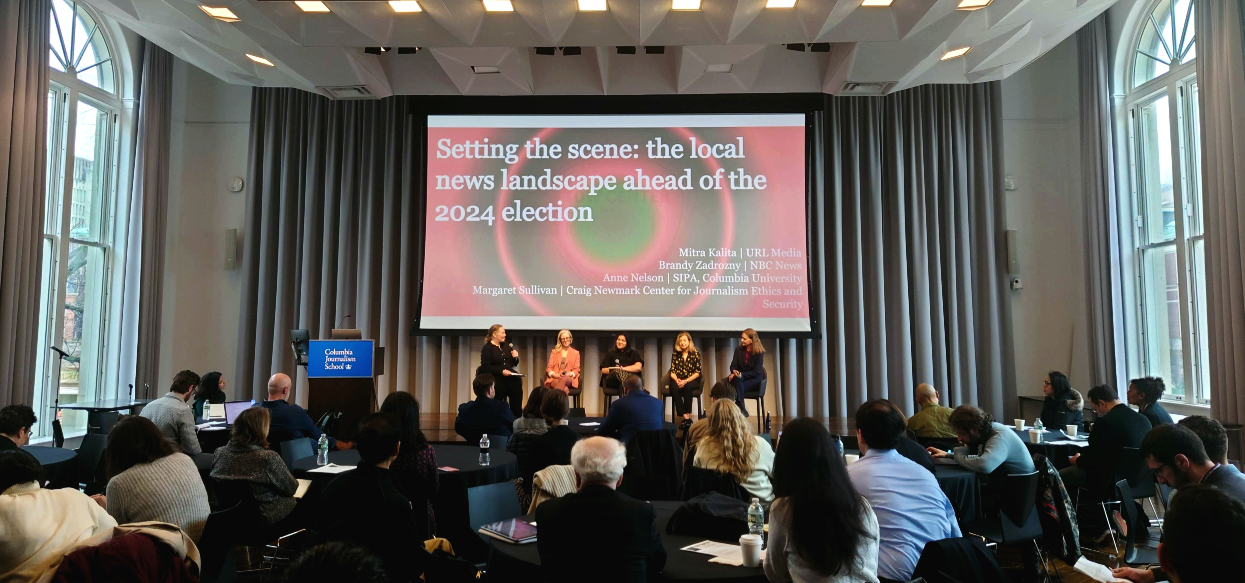Sign up for the daily CJR newsletter.
Usually, when an election cycle is approaching, people pay closer attention to the news. But in 2023, traffic to news sites and cable news declined. That reflects a deep dent in the media landscape, one that is only getting worse amid mass layoffs of journalists. Just last week, over a hundred and fifteen employees were laid off by the Los Angeles Times. The damage is especially grim among local newsrooms: approximately one-third of local newspapers across the US have closed since 2005. In their absence, partisan local outlets with ties to special interest groups have emerged. This kind of journalism, referred to as “pink slime,” floods the local news ecosystem with low-quality information and disinformation.
In a newly published report, the Tow Center has centralized an extensive series of work into pink slime and partisan local news. Last week, Tow brought together scholars, journalists, and policymakers to discuss the implications of dark money seeping into local news—detailing the extensive, secretive connections between political donors, advocacy groups, and ultra-partisan local news websites in the United States. You can watch the full livestream here.
Local news remains relatively trusted among Americans, even as overall trust in the media has plummeted to a historic low. According to a poll from Gallup and the Knight Foundation, Americans are about twice as likely to express trust in local news rather than national news to give them the information they need to vote. Margaret Sullivan, the executive director of the Newmark Center, said that local news serves a vital purpose by knitting communities together. “One of the reasons that local journalism is relatively trusted is that it’s not coming from an extreme,” she said. “It’s attempting to be reasonably fair.” Local newsrooms provide the public with information about their community, such as where to get a COVID-19 test and how to vote. And yet these newsrooms are being hollowed out at an alarming rate. “More than two newspapers are going out of business a week in the United States,” Sullivan stated.
Studies show that the decline of local news has led to increased political polarization. The information vacuum left behind is filled with pink slime content and outlets aimed at spreading misinformation. According to Letrell Crittenden, director of inclusion and audience growth at the American Press Institute, part of the reason why partisan news has been so successful is because it engages with local communities. While problematic, he said, partisan news actively tries to connect with people, drawing in various voices and audiences. Newspapers and newsrooms, he said, need to do more engagement. This includes identifying key players inside the community and developing a plan for connecting with them in the future.
Another problem ahead of the 2024 election is the amount of misinformation consumed on social media. According to Brandy Zadrozny, senior reporter at NBC News, misinformation has spread on these platforms during the past two elections. Perhaps most memorably, misinformation around the 2020 election culminated in the attack on the Capitol. As the 2024 election approaches, social media companies have reduced efforts to combat misinformation on their platforms. Twitter, for instance, has shifted toward a less transparent approach by making its API prohibitively expensive and cutting its trust and safety team. This adds another layer of difficulty in getting accurate information surrounding the election into the hands of the public.
As the news environment becomes more regulated, it becomes harder to decide what counts as “real journalism.” For instance, hyperpartisan outlets like Courier Newsroom blur the line between journalism and advocacy. According to Anna Brugmann, director of policy at Rebuild Local News, it’s crucial for newsrooms to disclose their end-of-line ownership in order to be considered journalism: “It’s not looking at the journalism, it’s looking at what are the structures that manifest your ethics and your finances in your practice.”
Jay Rosen, an associate professor at NYU who has worked as a consultant for Courier, stressed the need to look at all manner of subsidy systems, especially now that journalism is in a crisis. “I don’t think we’re being creative enough in looking at our alternatives,” he said. “People in journalism have to take on the issues of subsidy as their own, even though they came into this business to tell stories.”
Click here for Tow’s full report
Click here for the full event recording
Has America ever needed a media defender more than now? Help us by joining CJR today.









